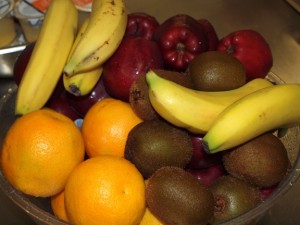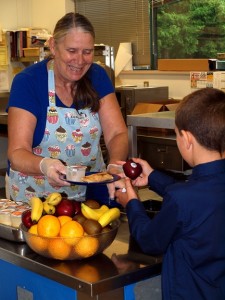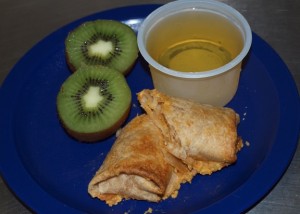By Amy Riggs

We all want what is best for our kids, and sending them to school ready to learn– well rested and well fed—is usually within our grasp. After all, our kitchen is our domain – assuming we accept that challenge. Sometimes, though, life gets in the way and the fridge is empty on the same day we have an early morning meeting or work that calls us out of town.
On those occasions, Olympia School District parents can rest easy, knowing Child Nutrition Services has healthy breakfasts covered – for just $1.50 per child.
After federal school food guidelines remained stagnant for 15 years, food services in schools across the country are in year two of implementing upgraded standards. While this means more restrictions on the food offered, the increased standards benefit our children. At the same time, Olympia School District’s Child Nutrition Services Department (CNS) has been ahead of the game for years by partnering with local farmers and small businesses to offer plenty of organic and local food choices to students.
In fact, CNS Director Paul Flock shared that the district has been partnering with Olympia business Bagel Brothers for more than ten years. This strong relationship with a small business is sustainable because as a small business, Bagel Brothers can “turn on a dime” and adjust recipes to meet the changing

requirements.
Quite like the meals I make in my own home, school breakfasts are now driven by whole grains and balanced offerings of dairy, fruits, and proteins. Children are
given more choices but also are held to maximum selections of one nutrient (no carb-loading – they’ve got to eat their fruit and dairy, too!).* Grain choices must be 50% whole grain and frequently include such kid-friendly options as cereal, waffles and pancakes with locally made syrups and Bagel Brothers’ bagels (the latter at the middle and high schools).
Glasses of water also are an added option (and requirement) as an alternative to two choices of milk: fat free or two percent. And fruits, I was happy to learn, cannot just be offered as juices. Vegetables generally enter the variety at lunch time.
On a follow-up visit to the Olympia High School cafeteria, CNS Director Paul Flock was excited to show me boxes of fresh lettuce, carrots, cucumbers, squash and kale that had just been received from the local gardening program GRuB (Garden-Raised Bounty), which would be incorporated into the day’s lunch and beyond. He also mentioned how, in partnership with the Thurston County Food Bank , leftover foods from all the schools are then collected for sharing through their food rescue program.
In addition to the meal calendars (aka lunch menus), Olympia School District’s Child Nutrition Services’ Web pages are a great resource for detail about the school food programs and nutritional information on specific items. It also includes a video that introduces the new federal guidelines, which are currently in implementation. There, CNS also shares Wellness monthly newsletter available throughout the school year, of which the September issue should be posted online in the coming days.

So, now that you know you have an option for those days when everything is working against you, here are a few ideas for low effort-high results breakfasts at home. After all, even Paul Flock admits that they “can’t compete against Mom—but sometimes moms have to work.”
- Overnight oatmeal with diced apples, raisins and toasted walnuts
- Yogurt, granola and berry parfaits
- Toasted English muffin half with deli turkey meat and cheese, juice or smoothie
- Sliced hard-boiled egg on buttered whole grain toast, kiwi fruit, chocolate milk
* Minimums have always been a guideline, but maximums are a new requirement in order to maintain the balanced plate.























































